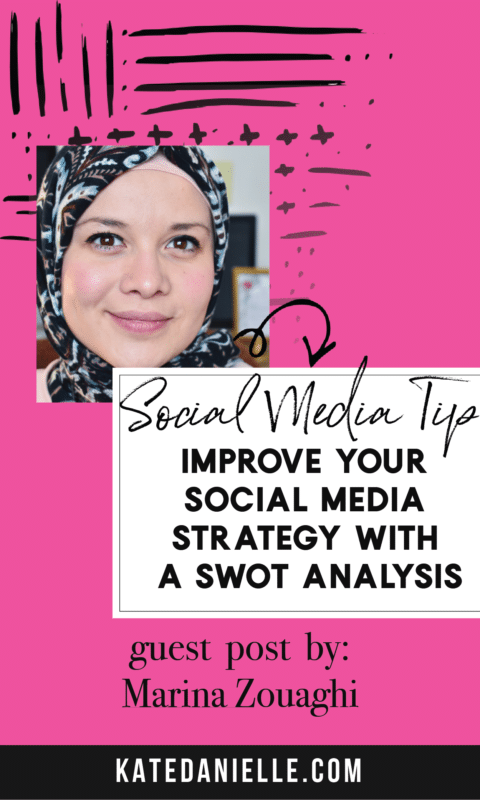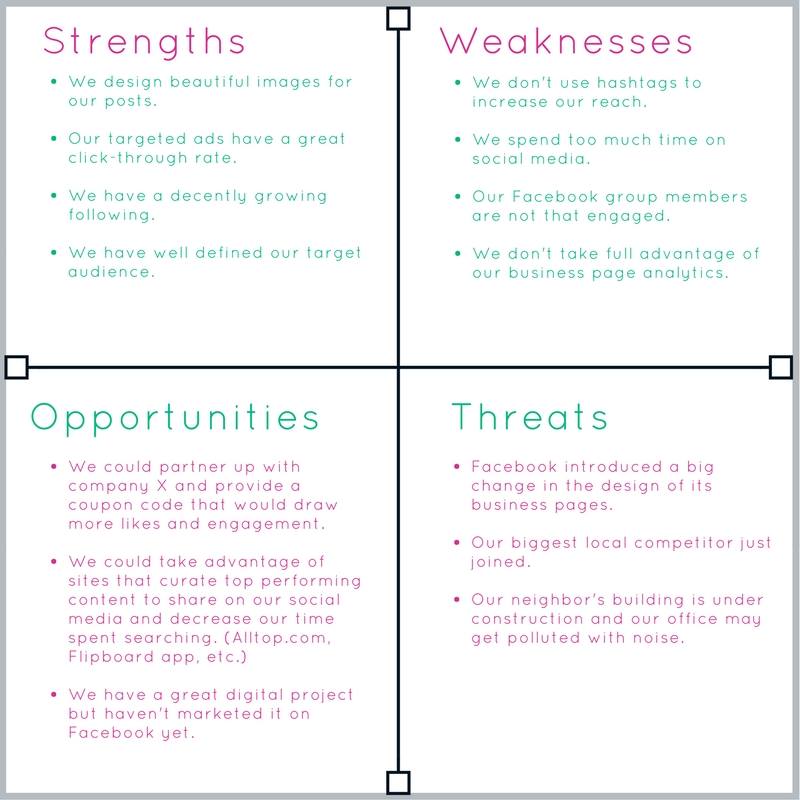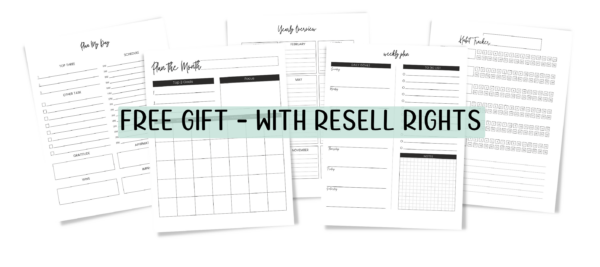Improve Your Social Media Strategy with a SWOT Analysis

The other day in Michaels (a store I visit weekly) I was flipping through a pretty business goals journal that was full of prompts. I stopped when I came across the SWOT analysis page… man I haven’t done one of these since college.
So when Marina pitched the idea for a guest post on using a SWOT analysis to improve your social media strategy I knew I had to have her on the blog. When things start showing up over an over in my life I take note plus I already bought the pretty journal… (my notebook addiction is real, y’all).
If you have no idea what a SWOT is don’t worry (I wouldn’t know if I wasn’t forced to learn it for my college course) Marina will explain it all below…

SWOT Your Way to Better Social Media | Guest Post by Marina Zouaghi
So you’ve planned out this month’s social media posts, images, captions, and hashtags. You’ve designed beautiful graphics that convey a strategic message to your target audience. Everything is scheduled for auto-post, and you’ve even stretched out your thumbs, so they are in tip-top shape for responding to all of the engagement you are sure to receive.
Then nothing. Well, your mom comments, but that’s it.
You invest so much of your time in your social media, but is it working? That’s when conducting a SWOT analysis could help.
What is a SWOT analysis?
A Strength, Weakness, Opportunity, and Threats (SWOT) analysis is a framework that has traditionally been used by the business world to take a critical look at the internal and external factors that could be contributing, harming, providing opportunity or posing a threat to the business’s success. Applying this framework to your social media strategy to better stay relevant and desirable to your target audience is easy. Before starting, however, you should have your goals and objectives for each social media outlet, i.e., Facebook, Twitter, Pinterest, Instagram, etc. in front of you for reference. And yes, I would recommend doing a separate SWOT for each medium. Your strength on Instagram might not be a strength on Twitter or you could be rockin’ Facebook and floppin’ on Pinterest.



STRENGTHS
Strengths are the internal strategic factors that you are doing a great job at! These are the things that are in your control because they are inside of your business. Brainstorm what you are doing that is working well. Here are a few things to consider.
- Branding and design – (Are you consistent in your use of texts, colors, design style, etc.)
- Engaged followers – (Do your captions/ posts/ descriptions all have a call to action that promotes engagement?)
- Analytics – (Are you using your business page analytics to their fullest?)
WEAKNESSES
Weaknesses are the internal strategic factors that could use some improvement. Your goal should be to turn these into strengths when you revisit your SWOT in the future. But for now, think about the following.
- Scheduling and consistency – (Are you using an editorial calendar to help you stay consistent?)
- Team resources and time management – (Is your team small? Could you outsource some work to increase efficiency?)
OPPORTUNITIES
Opportunities are external strategic factors that you haven’t taken advantage of yet but could, or haven’t even thought of until you began this process.
- Education – (Are there classes, workshops or conventions that you could attend or sign-up for?)
- Source of revenues – (Are you only using ads as a source of income on this outlet? Could you monetize other aspects of your social media?)
THREATS
Threats are external strategic factors that you can’t control, should be aware of and might want to prepare for. They could be anything from some significant changes the medium had set a date for (like when Instagram changed their algorithms) to a strong weather storm the news channels announced that might affect your internet connection.
- Competition and copycats – (Do you have a lot of competitors or are they well established? Is there a particular business that you want to keep an eye on?)
- Negative users – (Do you have procedures in place for how to handle the inevitable negative comments from trolls?)
Take a look at the graphic that I created for a quick and simple example for company X on Facebook.

Now that you have created a SWOT, what should you do with it?
SWOT Action Steps
1) Take a close look at the items you have written and pull out things that you should be doing or changing to help increase your success.
2) Organize them via priority.
3) Break them down into tasks.
4) Schedule those tasks in your planner to get done.
5) Now write down when you plan to review your progress and assign a future date to revisit and revise your SWOT to further reach your goals.
The SWOT framework is simple and versatile. Once you get the hang of it, try using it in other parts of your business as well. Use it to evaluate your email lists, your blog posts, your Etsy shop, your team or your business model, etc.
I would love to read about how this process has helped you switch things up for the better in the comments below!
About Marina | Overt Happiness
Marina creates articles and posts for businesses who are looking for engaging content. She also take photographs for people who are yearning to capture exciting moments.
As a freelancer, she has written three award-winning applications for entrepreneurs entering their businesses into the Better Business Bureau Ethics Torch Awards. She’s been writing and creating different forms of social media content, promotional material, and internal documents since 2007.



Great post!! Altough the social media aspect does not apply to me yet I will keep this in mind when I maybe start my own blog in the future!! We also do these SWOT analysises in Nursing. Plus, they are great to use when you have a habit to kick!
Wow…I have never heard of a SWOT analysis. I’m definitely going to do this for IG…thanks 🙂